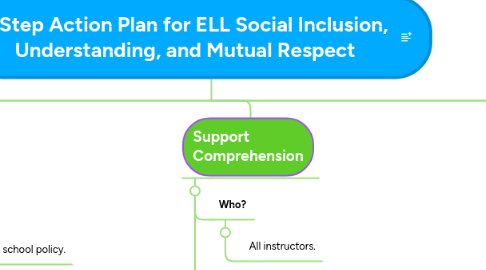
1. Warm School Culture
1.1. Who?
1.1.1. Classmates, teachers, campus community, everyone.
1.2. What?
1.2.1. Welcome global cultures and ethnic heritage not just individual people.
1.3. Where?
1.3.1. Classrooms, campus, publications.
1.4. When?
1.4.1. 24/7
1.5. Why?
1.5.1. A welcoming learning environment supports an openness to learning. See Krashen's fifth hypothesis for more on this idea.
1.6. How?
1.6.1. Celebrate culture and learning with school-wide events, imagery, music, food, poetry, films, PTA hosted activities and class-level curriculum.
2. Adapt Assessments
2.1. Who?
2.1.1. The teacher, based on school policy.
2.2. What?
2.2.1. Informal, formative and formal assessments.
2.3. Where?
2.3.1. In class or the given learning setting, but informal assessments can take place anywhere and at anytime. It could simply be a question tailored to a student's proficiency level.
2.4. When?
2.4.1. During scheduled assessments or a spontaneous informal assessment (e.g. having a child read aloud in class). .
2.5. Why?
2.5.1. An L2 language barrier does not mean the student does not know the subject in L1. Adapting assessments would offer a more accuracy view of subject knowledge.
2.6. How?
2.6.1. Adaptations could include reducing the number of items on a test or providing more time to complete a test (ICLP, 2011, p. 312).
3. Tailor Interaction
3.1. Who?
3.1.1. Differentiate instruction as needed for all ELLs.
3.2. Where?
3.2.1. In any learning environment.
3.3. When?
3.3.1. Lesson planning and delivery or when a learner indicates no understanding.
3.4. Why?
3.4.1. Learner proficiency varies so teaching strategies must as well.
3.5. How?
3.5.1. The teacher has to understand each learner's proficiency level and then adjust instruction as needed in real time (i.e. scaffold).
4. Support Comprehension
4.1. Who?
4.1.1. All instructors.
4.2. What?
4.2.1. Scaffold content and assessments (ICLE, 2011)
4.3. Where?
4.3.1. The L2 learning environment.
4.4. When?
4.4.1. As needed. Students need to be challenged on occasion with "incomprehensible input," too. (Baharani, 2013, p. 43)
4.5. Why?
4.5.1. Comprehension is essential for academic progress. Plus, comprehension is necessary for building on prior knowledge (e.g. Bloom's Taxonomy).
4.6. How?
4.6.1. Scaffolding is a context-specific tool. For example, the content of a book may need to be adapted with more visual support or guided text (ICLE, 2011). Scaffolding could simply be a question asked to activate background knowledge, or the use of similes or metaphor to color or express a point.
5. Foster Collaboration
5.1. Who?
5.1.1. Teachers, parents, guardians, classmates, school community, PTA, PTOs i.e. everyone!
5.2. What?
5.2.1. Academic progress or lack thereof needs to be an ongoing conversation between the teacher and the learner's parent/guardian.
5.3. Where?
5.3.1. Meet at school, if convenient. Meet at home, if welcomed.
5.4. When?
5.4.1. Meeting immediately after a reporting period to explain grading is common practice.
5.5. Why?
5.5.1. School is just one part of the learning process. Home usually where the authority is, so life away from school can impact school work e.g. no completing assignments or unresolved behavioral issues.
5.6. How?
5.6.1. Build face-to-face relationships, invite parents/guardians on to the school's administrative system (e.g. RenWeb or Engrade, communicate through email, send a weekly newsletter, have room parents, plan PT conferences after report cards go out or before if a student is not making adequate progress.
